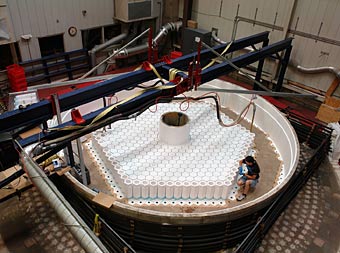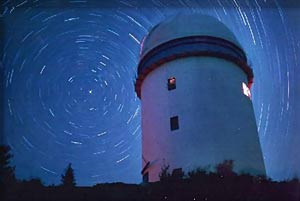 Casting team members at the Steward Observatory Mirror Lab loading 22,500 pounds of E6 Ohara borosilicate glass into the 6.5-meter honeycomb mold for the San Pedro Mártir Telescope mirror. (Ray Bertram, Steward Observatory, University of Arizona)
Casting team members at the Steward Observatory Mirror Lab loading 22,500 pounds of E6 Ohara borosilicate glass into the 6.5-meter honeycomb mold for the San Pedro Mártir Telescope mirror. (Ray Bertram, Steward Observatory, University of Arizona)Mirror cast for Mexican 6.5-meter infrared telescope
| 26 August 2009
BERKELEY — With the casting today (Wed., Aug. 26) of a 6.5-meter mirror in Arizona, Mexican and American astronomers have taken the first step toward creation of a major new telescope that will survey infrared objects in the northern sky with unprecedented sensitivity.
The new mirror is destined for the planned San Pedro Mártir Telescope, which would be built at the San Pedro Mártir Observatory in Baja California, Mexico.
When completed in 2017, the telescope will begin the Synoptic All-Sky Infrared Imaging Survey (SASIR) to look for faint infrared sources - ranging from dim, nearby stars to distant quasars - and flashes of infrared light from supernovas and other transient sources.
 Before being filled with glass, the mirror mold is loaded with 1,020 hexagonal cores. The cores will be removed after several months, when the mirror blank has cooled and been lifted off the furnace hearth, leaving the voids of the honeycomb glass structure. (Ray Bertram, Steward Observatory, University of Arizona)
Before being filled with glass, the mirror mold is loaded with 1,020 hexagonal cores. The cores will be removed after several months, when the mirror blank has cooled and been lifted off the furnace hearth, leaving the voids of the honeycomb glass structure. (Ray Bertram, Steward Observatory, University of Arizona)Project partners are the Universidad Nacional Autónoma de México (UNAM), the University of California, the Instituto Nacional de Astrofìsica, Ôptica y Electrònica (INAOE) and the University of Arizona in Tucson.
The estimated cost of the telescope is $200 million, which must still be raised from private sources or from U.S. or Mexican government funding agencies. UNAM is opening a project office in Mexico City next month, and Bloom is optimistic that money for a preliminary design can be raised by the end of the year, with continued funding to enable ground breaking in 2013. The all-sky infrared survey should start in 2017 and last 4 to 5 years.
"With this unique combination of telescope size, infrared design and survey strategy, SASIR will help us discover everything from the sun's nearest neighbors to the most distant black holes in the universe," Bloom said. "We believe that SASIR will have a tremendous scientific impact across all fields of astronomy."
"This is a great scientific project which will fully exploit the superb characteristics of the San Pedro Mártir site," said Jose Franco, director of UNAM's National Institute of Astronomy.
The project begins in earnest with the casting of a "honeycomb" sandwich mirror 6.5 meters (21.3 feet) in diameter by the University of Arizona Steward Observatory Mirror Laboratory in Tucson. The mold inside the 1,180-degree Celsius (2,156-degree Fahrenheit) giant rotating furnace holds 22,500 pounds of E6 low expansion borosilicate glass produced by the Ohara Corporation in Japan. The furnace will spin at 7.4 revolutions per minute for three days so that the mirror achieves the desired focal ratio, f/1.25.
"We are thrilled to help launch this scientific collaboration between UA, the UC and Mexico," said Steward Observatory Director Peter Strittmatter. "We expect the partnership to continue long after the survey is completed."
"The University of Arizona has a long history of collaborations with Mexico based on synergies among equal partners," said UA College of Science Dean Joaquin Ruiz. "This is a case in point in which the strengths and needs of our Mexican partners perfectly complement our own strengths and needs to make a win-win situation for all. I am glad that The University of Arizona will be part of this astronomy venture - a venture that has the promise of greatly increasing our understanding of our universe."
 This 2.12-meter telescope is currently the largest at the San Pedro Mártir Observatory in Baja California. By 2017, it should be joined by a 6.5-meter telescope to survey infrared sources in the northern sky. (Courtesy of San Pedro Mártir Observatory)
This 2.12-meter telescope is currently the largest at the San Pedro Mártir Observatory in Baja California. By 2017, it should be joined by a 6.5-meter telescope to survey infrared sources in the northern sky. (Courtesy of San Pedro Mártir Observatory)When equipped with the SASIR camera bearing the largest collection of infrared detectors to date, the San Pedro Mártir Telescope will offer an unprecedented view of the infrared night sky, Bloom said. The telescope will be able to detect objects 100 to 500 times fainter than the best infrared survey to date, the 5-year-old Two Micron All Sky Survey (2MASS).
The team hopes to find the most distant quasars, which are actively forming galaxies from the very early universe, and detect dim red stars that may comprise the missing mass in the neighborhood of the sun. SASIR may also find Earth-sized planets around dim stars.
"This is a remarkably strong collaboration between two U.S. and two Mexican research groups," said Jose Guichard, director general of INAOE. "The project, however, still welcomes other partners."
For more information, link to:
University of Arizona's Steward Observatory Mirror Lab
University of Arizona press release

